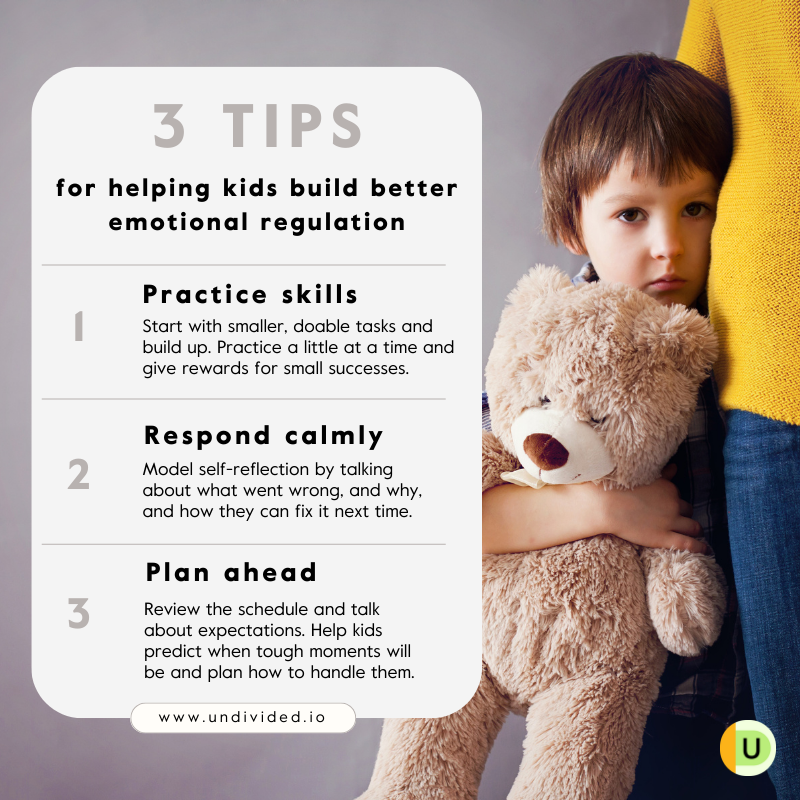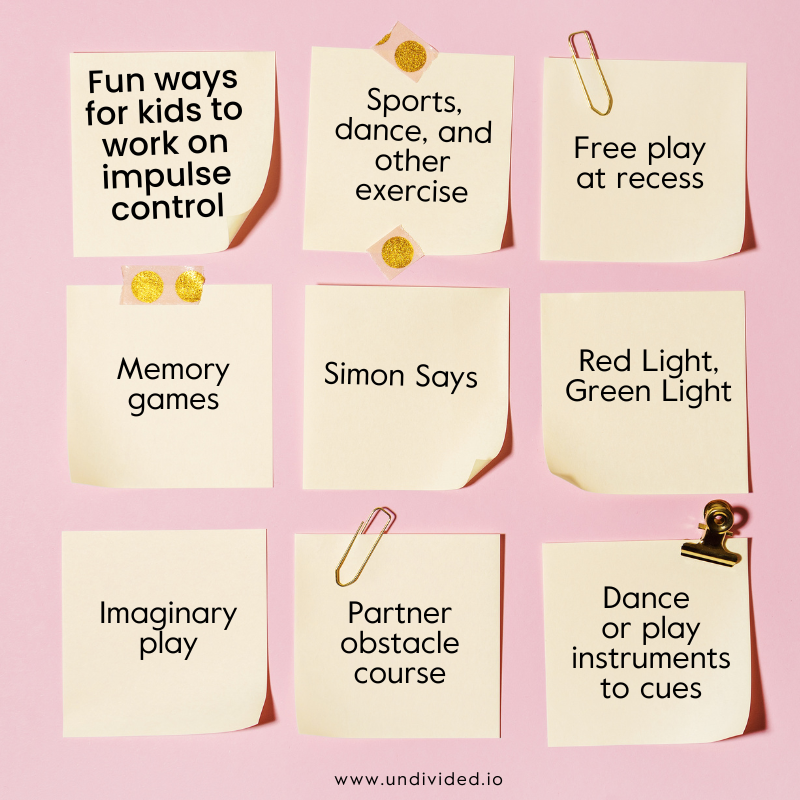Tips for Building Better Emotional Regulation
Emotional regulation is the ability to control emotions and impulsive behavior. While for many kids these skills develop with growth and time, many others need strategies and support to learn them.
Below, we’ll discuss three specific approaches to helping our kids build better self-regulation and manage behaviors by: finding ways to calm themselves when they get upset; learning to deal with feelings of frustration without losing their cool; and looking for ways to problem-solve when confronted with an upsetting situation. Plus, Dr. Matthew Biel offers advice for parents to help kids get through tough emotions.
Strategy #1 - Scaffolding: isolate the skill needed and practice it
As parents, we tend to avoid the situations that we know will trigger our children’s behaviors — for good reason — but according to clinicians interviewed by the Child Mind Institute, we can coach our kids through these situations by providing them with the tools to develop the appropriate emotionally regulated responses. Using a process known as “scaffolding,” parents can encourage the desired behavior that is wanted until the child is able to handle it on their own.
For instance, if getting off video games is difficult, “scaffolding” could involve transitioning away from playing the game. Parents can start by having their child play a less-preferred game at first for a short period of time (two to three minutes) so it's not as difficult to stop the first few times. Children can earn points for a preferred activity or item each time they do it, and build up the minutes (and preferred games) from there.
Start with smaller, doable tasks and build up
According to clinical psychologist Matthew Rouse, PhD, consistency and beginning with smaller tasks can help both parents and children feel successful. We can break down the task, transition, or activity that causes the child to become dysregulated into smaller steps to make it more attainable and build confidence.
Rouse uses brushing teeth as an example: a parent can start by having the child only put the toothpaste on the brush and give positive input and rewards when the child follows through. Once the child has practiced a few times, add the next step.
Take a practice run
Another way to scaffold is by doing “dry runs.” If going to a store or doctor's office causes your child to have behaviors, first practice with short visits (when a parent does not need to actually shop or the child does not have an actual appointment). Praise and reward your child; the next time, maybe it's walking the aisle while keeping hands to themselves and or sitting in the waiting room of the doctor/dentist.
Give rewards for small successes
Dr. Rouse reminds us to motivate and encourage our children to take these small steps by praising them with positive verbal feedback and/or rewarding them with points earned toward preferred activities and/or items.
Strategy #2 - Use reflective feedback vs. an emotional response
Scott Bezsylko, another expert interviewed by Child Mind and the executive director of the Winston Preparatory School for children with learning differences, encourages parents to resist responding emotionally to a child’s outburst but instead to try and respond calmly. First, help them acknowledge “what went wrong, and why, and how they can fix it next time.”
He also suggests making space for children to self-reflect. “We need to slow down and model self-reflection and self-awareness and self-regulation for our kids,” he says, “but it’s also helpful and good for us, too.” Mindfulness and mediation can also be positive building blocks to help children build emotional regulation skills.
Strategy #3 - Prioritize activities for developing impulse control
In an article published by the Child Mind Institute, “Why Do Kids Have Tantrums and Meltdowns?,” mental health professionals agree that most children who tend toward emotional outbursts could benefit from building the skills needed for impulse control so that they’re prepared when frustration, anxiety, and anger strike.
There are a variety of activities parents can try with their children to build better impulse control. Here are a few to try:
Keeping kids active
One study by the University of Kansas found that “regular exercise alters the workings of portions of the brain involved in higher-level thinking and decision-making, which, in turn, play important roles in impulse control.” Giving children the opportunity to participate in sports, recess, dancing, and even exercising in the living room can help teach impulse control.
Playing memory games
Scholastic has an interesting article showing how memory games can actually help children with impulse control. They referenced research from Stanford University) and the Netherlands’ Maastricht University “that linked improved impulse control to short-term memory training” and found that “enhanced memory lightens the ‘cognitive load’ of the frontal cortex, allowing it to manage impulsivity more successfully.”
Playing control-building games
On a recent podcast from Tilt Parenting, Angela Pruess shares some helpful resources to help parents engage their children in control-building games — which can be a great starting point for teaching mental self-control.
Doubling down on creative play
In a 2008 National Public Radio story, researchers reported that children today do not learn to self-regulate as well because they spend most of their time in adult-directed activities. They point out that free play with siblings and friends can be when children learn “impulse control, but without that time, children don't develop their executive function skills.” Parents can help by making time in a child’s daily schedule for free play where they can make up “stories and songs, draft playmates as characters and turn sticks into magic wands.” Check out more ideas for helping kids socialize and build friendships with peers in this article.
Talking your kids through it
Dr. Matthew Biel, chief of child and adolescent psychiatry at Georgetown University Medical Center, won our hearts back in April when he sat down for a live chat with Undivided. With his trademark warmth and honesty, he shared with us how to help our kids through these moments — what he calls “flooding.”
Flooding — otherwise known as a meltdown — often occurs when kids feel unsure of what is expected of them, or when they feel they aren’t up to a particular task. Here are some pointers on navigating these tidal waves when they occur:
Plan ahead
As part of getting each day going, consider creating a schedule or review of “here’s what today looks like.” This can help your child get their head around what’s going to be expected of them. Planning ahead might also help both you and your child predict what and when the tough moments might be — for example, the point at which they need to get off of screens, or the time when they have to do a chore or activity that they don’t like. If you can flag a potential problem area, you can plant the seed for using the scripts.
Real-life example: “I know getting off-screen is tough. That could be a time when you feel stuck. What do you think would help you get unstuck? Deciding what movie we’re going to watch tonight? Going outside on your scooter?"
Conduct a post-mortem
In a calm moment, after an episode is well behind everyone, talk with your child about what happened and why.
Real-life example: “Hey, we all got really stuck earlier. I was making lunch, and you seemed to get kind of upset or angry, and then I didn’t know how to help you. I felt stuck. Did you feel stuck? Do you remember what made you upset? What could I have done that would have helped? What would help you to get unstuck? Oh, you were hoping we could go out for lunch? I didn’t realize that. So that was your plan A. If you have a plan A, will you tell me so that I know what it is? Sometimes we will be able to do plan A, but sometimes we may want to have a plan B.”
Be present
If your child starts flooding, even if it feels like nothing you do “works” (and indeed, you most often will just need to let things run their course), remember that your goal here is not to immediately end the episode. Instead, just try to “be in it” with your child. Don’t talk nonstop — they won’t be listening — but remember that silence will feel like condemnation. Just try to keep a neutral expression, let your child know that you see that they’re upset (or whatever word they use), and tell them that you’re here and you’ll help them. Try to be neutral, repeat yourself a lot, hold your ground, don’t try to fix it or end it or throw up your hands and stomp out. Just hold the center. The goal is to get through the episode.
Real-life example: “I hear you...you’re really angry. I hear you...okay...let’s figure this out...I hear you...”
“Then, when your child starts to settle down,” says Dr. Biel, “you can go out into the garden and scream into a hydrangea bush.”
Join for free
Save your favorite resources and access a custom Roadmap.
Get StartedAuthor




